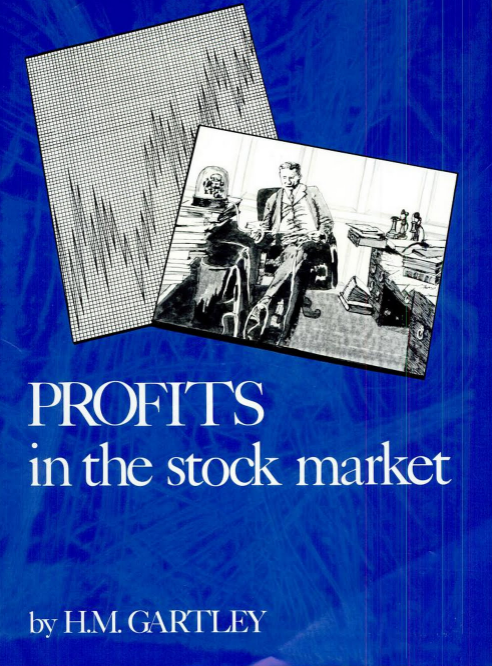Reading really old research is humbling. https://archive.org/ is an awesome place to start.
One quickly recognizes that market participants were very savvy way back in the day. I’ve always assumed that investors today are more intelligent and armed with better capabilities.
I question that assumption.
We almost certainly don’t have higher IQs, and I think our core understanding of how humans interact in a marketplace to balance their greed for profits and their fear of losses probably hasn’t developed much over the past 100 years. We’ve simply “rediscovered” things that people have identified at other points in time.
Technology and implementation may change, but in the end, capital is controlled by humans who still make the final decisions.
Some things never change.
An old-time book called, “Profits in the stock market,” by H.M. Gartley highlights the point. The book was initially published in 1935, but the discussions and arguments sound eerily similar to the same arguments and discussions that go on in the current market. We won’t comment on the specifics of what Gartley suggests because that isn’t the point of this post (even though he did talk about moving average rules almost a century ago!).
What is fascinating about Gartley is his understanding of how investors make investment decisions and the debates in the market over the best approaches and methodologies.(1)
First, there is the debate over systematic approaches versus discretionary approaches (a debate we’ve covered in depth). Our original thinking was that investors didn’t even consider systematic processes back in the “old days,” because they didn’t have computers/data and the body of research on behavioral biases had not been formally documented.
Errr. Wrong.
From Gartley:
The difference between losses and profits frequently hinges upon trading in a hit-or-miss fashion, or systematizing one’s speculation…it is the purpose of this course to encourage the reader to…[use] certain systematic methods which have proved profitable to successful traders…
Gartley doesn’t specifically recommend a 100% systematic approach as an end-all-be-all approach to solve everyone’s stock market woes, but he certainly strongly suggests this approach as an anchor of any investor’s decision-making process:
Most necessary of all to the average trader of moderate means is the importance of systematic speculation. To have a program and steadfastly stick to it is usually not a part of the customary approach to the stock market…the reason why a [systematic] program is so essential is because it permits the application of patience…
Next, Gartley brings up the two approaches to stock market investment: the fundamental approach and the technical approach. Again, his commentary helped to highlight my naivete. For example, we have a post, “Evidence based investing requires less religion and more reason.” We highlight that technical analysis has been around forever, but fundamental analysis emerged with Ben Graham and this philosophy took over the markets. This version of the story is probably wrong based on my prelim read of H.M. Gartley. Both fundamental and technical analysis have been around forever. For example, this snippet from the 1887 book, “Twenty Eight Years in Wall Street,” by Henry Clews, highlights the reliance on fundamentals being prevalent well before Ben Graham even hit the scene:
There has hardly been a year within my recollection, going back nearly thirty years, when there have not been two or three squalls in “the Street,” during the year, when it was possible to purchase stocks below their intrinsic value…
Perhaps Ben Graham just had better branding? His star student, Warren Buffett, created a tsunami of copycats, availability bias, and media attention. So maybe we perceived fundamental analysis to be a “new thing,” but according to my prelim read via Gartley — fundamental analysis has always been part of the stock market game?
Gartley has his own criticisms of Ben Graham when it comes to poo-pooing the art/science of technical analysis. Gartley starts with an intro to the problem:
It is obvious that there is a great misunderstanding of the differences between mechanical chart trading…and logical technical study which has proved profitable…”
Next, he quotes Ben Graham:
That chart reading cannot be a science is clearly demonstrable. If it were a science, its conclusions would be as a rule dependable.
He then puts the question back at Graham:
Can it be demonstrated that the conclusions resulting from security analysis are, as a rule dependable? If so, are they vastly more dependable than conclusions arrived at by means of technical studies?
Gartley quotes Graham and Dodd again, this time suggesting that technical techniques have never proven profitable over long periods of times. Gartley snaps back and states that the Dow Theory has been used with high degrees of success for 40 years. (turns out the strategy may have also worked from 1930–>).
Gartley goes back and forth regarding Graham and Dodd’s simple dismissal of technical analysis without considering the evidence. (Highly recommend you read it for yourself (pages 6-8)). After ranting on Graham and Dodd for a bit, Gartley closes with some timeless commentary:
Naturally, there is little reason for the proponents of either fundamental or technical analysis to worry about numberless traders speedily adopting the useful methods employed in selecting securities and timing commitments. At least 95% of those who enter the stock market…are simply too lazy…
Gartley, mentions the word “lazy,” but in context, it is beyond the direct connotation of “not working hard” and is really a bash on those investors who never follow a process and believe in “hope.” He ends with a classic line:
The market opinion of this 95% is at heart the perennial human hope to make something for nothing…
Well said Mr. Gartley, well said.
References[+]
| ↑1 | In fact, there was a book published in 2010 that suggests that Gartley’s techniques have held the test of time. |
|---|
About the Author: Wesley Gray, PhD
—
Important Disclosures
For informational and educational purposes only and should not be construed as specific investment, accounting, legal, or tax advice. Certain information is deemed to be reliable, but its accuracy and completeness cannot be guaranteed. Third party information may become outdated or otherwise superseded without notice. Neither the Securities and Exchange Commission (SEC) nor any other federal or state agency has approved, determined the accuracy, or confirmed the adequacy of this article.
The views and opinions expressed herein are those of the author and do not necessarily reflect the views of Alpha Architect, its affiliates or its employees. Our full disclosures are available here. Definitions of common statistics used in our analysis are available here (towards the bottom).
Join thousands of other readers and subscribe to our blog.



